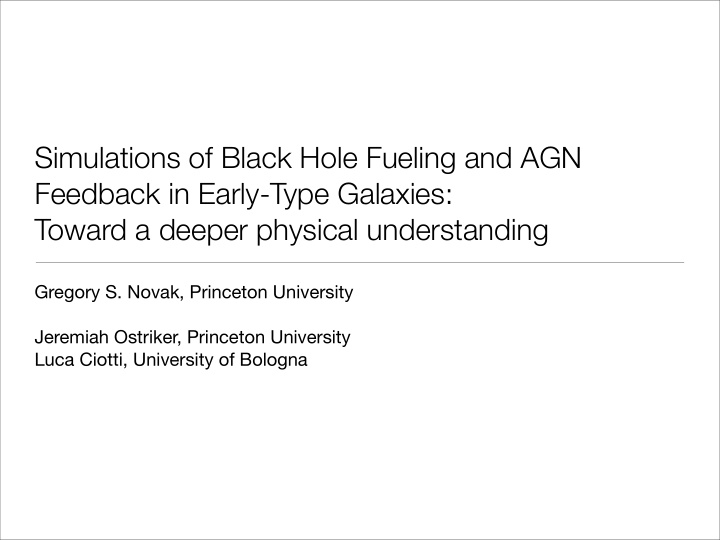



Simulations of Black Hole Fueling and AGN Feedback in Early-Type Galaxies: Toward a deeper physical understanding Gregory S. Novak, Princeton University Jeremiah Ostriker, Princeton University Luca Ciotti, University of Bologna
Goals • Understanding of BH fueling and feedback are in an embryonic state. • Implement a physically rich AGN feedback model • Ensure that physically relevant length and timescales are resolved • How does BH accretion affect energy, mass, and momentum balance of galactic gas?
Related work • DiMatteo, Springel + Hernquist 2005 • Levine, Gnedin, Hamilton + Kravtsov 2008, 2010 • Alvarez, Wise + Abel 2009 • Booth + Schaye 2009 • Johansson, Naab + Burkert 2009 • Debuhr, Quataert, Ma + Hopkins 2010, 2011 • Hopkins + Quateart 2010 • Kim, Wise, Alvarez + Abel 2011
Basic Picture • Early-Type Galaxy with initial population of stars, no gas • Gas supplied by evolving stars, cools unstably, falls to center of galaxy • Simulation domain 2.5 pc to 250 kpc, run for 10 Gyr
Length and Timescales • Bondi radius of HOT gas: ~5 pc • Sphere of influence of the black hole: ~20 pc • Accretion disk timescales: ~10 4 yr • Stellar evolution timescales (source of infalling gas): ~10 9 yr • Galactic Length Scales: ~kpc • Smallest cells: 0.2 pc • Courant time in smallest cells: ~1 yr
The need for high resolution • Bondi Radius depends strongly on sound speed • Radiative AGN Heating depends strongly on radius • Sufficiently strong heating can cause the Bondi radius to “overtake” the gas • Gas inside the Bondi radius corresponding to the Compton temperature is energetically required to interact with the BH. • The simulation should resolve the Bondi radius for gas at the Compton temperature
In general, pick two of: • ~Parsec resolution • ~Gyr simulation times • Strong AGN heating and/or outflows
Physically Rich Feedback Model • Radiative and Mechanical Feedback via Energy and Momentum • Mechanical Feedback via 10,000 km/s Wind driven off of (sub-resolution) Accretion Disk • Radiative Transfer of AGN and Stellar Photons due to Dust Opacity • Dust Destruction via Sputtering, Creation via Stellar Winds, Molecular Clouds • Compton Scattering/Heating, Photoionization Heating/Opacity, Atomic Cooling, Bremstr. • Star Formation, Supernovae
Effect of Changing Inner Radius Data Points From: Heckman et al 2004 Greene + Ho 2007 Kauffmann + Heckman 2009 Ho 2009
Effect of Changing Inner Radius
Eddington Rate in Point Mass + SIS potential
Effect of Changing Inner Radius • If BH sphere of influence is unresolved, Eddington ratio will be too high • Large Eddington Ratio bursts are very effective at heating essentially all of the gas in the galaxy and driving outflows • Easy to understand: Requiring that • gives: (e.g. Silk + Rees 98)
Effect of Dust • BH, Stars emit UV, Optical, IR photons • As you absorb UV/Optical photons, that energy is added as IR photons • We solve the radiative transfer equation with scattering, absorption, an arbitrary source of isotropic photons (stars) and a central point source (BH) in the radial direction by taking moments of the equation.
Effect of Dust Dust does not seem to make a large difference
Effect of Dust • Dust only makes a big difference when you’re already ~Compton thick. (allowing for dust destruction makes dust yet less important) • For ABSORPTION: photons get used up • For SCATTERING: photons build up and diffuse out (see Thompson, Quataert + Murray 05 Murray, Quataert + Thompson 05 Debuhr et al 10, 11)
Effect of Dust Given enough gas, dust can make a large difference
Conclusions • Momentum injected by broad-line wind is the dominant factor in determining black hole growth • Physics operating between 3 pc and 100 pc makes a difference! • Dust does not seem to make a big difference... • Unless there’s enough gas to be optically thick in the IR (nearly Compton- thick), then it does make a difference
Recommend
More recommend